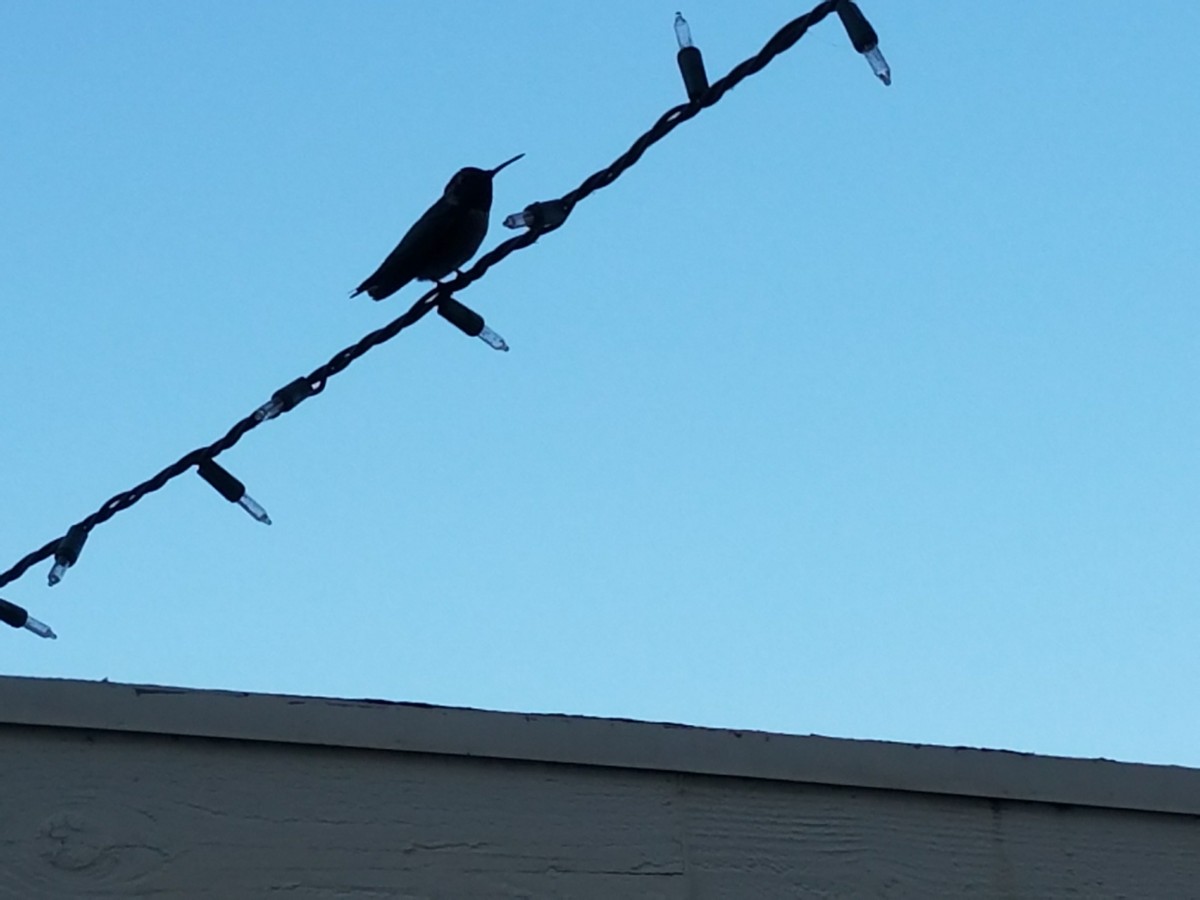This post contains affiliate links.
While looking out my kitchen window and watching the hummingbirds zip around my patio I wondered, if a hummingbird has a high metabolism during the day, how do they survive through the night? I did some research and decided to write a helpful post on my findings.
How do hummingbirds conserve energy at night while they sleep?
Hummingbirds reduce their body temperature, heart rate and breathing rate to only 5% of their normal energy expenditure during the day to conserve energy at night while they sleep. This state of reduced metabolic activity is known as torpor (pronounced TOR-per). It closely resembles death.
The smallest warm-blooded vertebrate is the hummingbird. They maintain a steady core body temperature during the day and yet, at night, they reverse their body heat and adapt to a low atmospheric temperature.
The absence of down feathers decreases insulation and aids in lowering their internal body temperature to match their surroundings and enter a state of torpor.
However, due to their lack of down feathers to regulate a normal body temperature like other birds, hummingbirds have been known to become extremely cold at night.
Hummingbirds that are in torpor will reflect or mirror their body temperature to the environment around them. When hummingbirds are not in torpor they generate high body heat to keep themselves warm throughout the day.
Due to the petite size and high metabolism of a hummingbird they have huge hurdles to overcome every night. While in torpor, they can look like they have stopped breathing but are still very much alive.
Through environmental changes, evolutionary adaptations have become the central component in continuing the prosperous existence of hummingbird’s on this earth.
Over many generations, hummingbirds triumph over these everyday challenges.
In order to meet these demands successfully, hummingbirds slow all of their bodily functions and go into a hypothermic-like state.
Body Temperature
How low does a hummingbird’s body temperature drop while they are sleeping?
While sleeping, a state known as torpor, a hummingbird’s body temperature can drop from their normal daytime temperature of 105 degrees Fahrenheit (40 degrees centigrade) to as low as 48 degrees fahrenheit (9 degrees centigrade) at night in colder regions. They do this in order to conserve energ
A hummingbird’s body temperature can reach a hypothermic set point far lower than similarly sized birds whose metabolisms have been recorded.
Studies provide evidence of photographs using a camera to capture thermal infrared images and examine the heat distribution of a hummingbird.
The study provides two images side by side showing one hummingbird during normal day time activity producing high body heat while the other image is almost non existent because the hummingbird is in torpor.
The first image exhibits the most condensed coloration of red and yellow near the brain and heart. The colors represent the location where the maximum amount of heat is produced. These two vital organs of a hummingbird are the most important to sustain life.
The second image displays a hummingbird in torpor. It embodies a faint glowing red outline of the heart. The hummingbird’s silhouette is almost non-existent and blends into the background since the hummingbird reflects the temperature of its environment.
This emphasizes the significance of how well a hummingbird is able to conserve energy at night.
Heart Rate
What is the heart rate of a hummingbird at night while in torpor?
When hummingbirds go to sleep at night their heart rate drops to approximately 50 beats per minute as compared to their normal daytime heart rate of 1250 beats per minute. In fact, the heart rate is so low when in torpor that a hummingbird has to “jump-start” their heart to wake up every morning.
During torpor the heart rate slows down drastically and the hummingbird can appear to look dead even though they are very much alive.
This may seem to us as being an impossible adaptation that occurs every night, but in actuality it is a normal response for survival.
Hummingbirds do not have to think about this adaptation, rather it happens unconsciously. For example, we do not notice when or how many times we breathe a day. Our body does not need to inform us to breath, we can multi-task and perform breathing functions naturally.
This autonomic response is achieved every night for hummingbirds when they go into torpor.
This daily phenomena and everyday hurdle is truly astounding and unbelievable to witness.
Breathing
What is the hummingbird’s respiration rate while sleeping?
A hummingbird drops its breathing rate so low that breathing is imperceptible, however I could not find a precise number on a hummingbird’s respiration rate.
At rest, a hummingbird breathes about 250 times per minute compared to a human’s 15 -19 breaths per minute. The breathing rate increases to 1250 times per min when the hummingbird is in flight.
Their respiratory system is designed to hold a large capacity of oxygen to sustain the required physical demands of the body.
Oxygen is inhaled through small nostrils at the end of the bill and goes into two small lungs. The lungs are connected to air sacs. Pressure from the muscles while flying pushes air in and out of these air sacs providing fresh oxygen to the bird’s brains and muscles for proper function.
Types of Torpor
The duration and type of season distinguishes the type of torpor and how long these animals sleep. Some experts compare torpor to hibernation.
See the experts research at National Institutes of Health here….
The typical definition for hibernation is the condition or extended period of slumber or inactivity during the winter months. We typically associate this behavior to bears becoming dormant for 6 to 7 months out of the year during the winter.
Unlike bears that hibernate for long periods of time, hummingbirds use a daily temporary hibernation that occurs every night called torpor.
Hummingbirds do not enter torpor only at night but have been known to enter stages of torpor when food is scarce or difficult to find, when the weather is too cold or during heavy periods of rain.
Torpor Recovery
How long does it take a hummingbird to recover from torpor?
It takes a hummingbird on average between 20 min in warm weather to 1 hour in cold weather to recover from torpor. While their heart rate and breathing increases, the vibration of their wing muscles produces a “shivering” affect to generate heat.
A hummingbird’s biological clock will automatically initiate the reverse of torpor 1-2 hours before the sun rises.
The first thing they do after successfully reversing the state of torpor is consuming 25% of their daily intake of food. This is an evolutionary adaptation for survival.
In fact, recovering from torpor is a difficult and time consuming process. Sometimes a hummingbird can die because it cannot properly make the transition from torpor to normal daytime activity.
Hummingbirds have been known to go into torpor while feeding and have been found hanging upside down attached to a feeder. This occurs when a hummingbird is unsuccessful in filling their reserves before sundown and have not found a safe place to perch for the night.
As important as it is for hummingbirds to feed before going into torpor it is just as imperative for them to feed right after they reverse torpor.
Success Rate of Recovering from Torpor
When morning temperatures become warmer as summer approaches it is easier for hummingbirds to reverse the state of torpor.
Successful torpor recovery happens when:
- Hummingbirds have filled their energy reserves at the end of the night before entering torpor.
- The summer months are warmer.
- Not being eaten by hungry night predators while they sleep.
During the cold nights it is especially important for a hummingbird to consume and replenish their food supply prior to going into torpor. They require enough fuel to last through the night and be able to wake up successfully. The morning goal for them is to see another sun rise.
Pleasant weather leaves less of a strain on a hummingbird’s body when transitioning and recovering from torpor.
Locating a safe and secure perch for the night before going into torpor and not being stranded on a hummingbird feeder will better the chances of a hummingbird surviving and not being consumed by cats, praying mantises or hawks.
Hummingbirds who are stronger will continue to live, survive and are successful in procreating and passing on their desirable biological traits.
If you still have concerns and are not convinced the health of the hummingbird is stable, contact your local animal rehabilitation centers or animal hospitals for guidance and assistance.
Final Thoughts:
Hummingbirds go into a daily hibernation like state called torpor every night. They must reduce their body temperature, heart rate and breathing to create the appearance of being almost dead in order to conserve energy at night.
They have to jump start their heart every morning in order to reverse the state of torpor. This process can take anywhere from 20 min to 1 hour depending on the weather.
If hummingbirds are unsuccessful in filling their bellies at night before bedtime and the weather is too cold than this failed attempt can lead to death.
Sleep is important for healing and repairing heart and blood vessels along with rebuilding muscles and joints. The most important ability for a hummingbird is to reverse torpor so they can enjoy another day.
This adaptation aids in the survival rate for hummingbirds and keeps their heritage alive for future generations.
Happy Hummingbird Watching!
Backyard Visitors participates in affiliate programs which compensate us for referring traffic.


